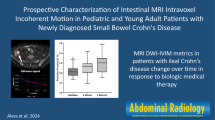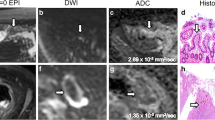Abstract
Purpose
Crohn’s disease has been associated with restricted diffusion in diseased small bowel segments on diffusion-weighted imaging (DWI). However, data addressing longitudinal changes in DWI findings and their potential clinical ramifications in the pediatric population are lacking. The purpose of this study was to follow DWI changes in diseased small bowel segments between serial magnetic resonance enterography (MRE) examinations, and to correlate these changes with other imaging parameters and clinical status.
Methods
This retrospective study evaluated patients less than 21 years of age undergoing serial MRE examinations including DWI for Crohn’s disease involving the small bowel. All patients carried a diagnosis of Crohn’s disease established by pathology or corroborative clinical and imaging findings. Longitudinal changes in mean apparent diffusion coefficient (ADC) values within the wall of affected small bowel lesions were recorded and normalized to both unaffected bowel and skeletal muscle. ADC changes were correlated with qualitative imaging phenotype, as reflected by a defined set of non-DWI imaging parameters, as well as with clinical disease activity.
Results
Seventeen lesions were evaluated longitudinally, distributed among 13 patients (9 boys and 4 girls, mean age at baseline 16.6 years), each of whom had two sequential MRE examinations. Lesions demonstrating a fibrostenotic imaging phenotype at follow-up MRE had a significantly lower change in mean ADC value between examinations than lesions that did not have a fibrostenotic imaging phenotype (p = 0.0005), an effect that persisted when ADC values were normalized to unaffected bowel and skeletal muscle. Across all studies, lesions with a fibrostenotic imaging phenotype had lower ADC values than those with an inflammatory imaging phenotype, which were in turn lower than those with a normal imaging phenotype (p = 0.0001).
Conclusion
Patterns of longitudinal DWI changes in Crohn’s disease may differ among small bowel lesions depending upon their specific natural histories. These findings may assist in the evaluation of the ADC value as a potential imaging surrogate when evaluating lesion status, particularly as it pertains to relative contributions of inflammation and fibrosis.


Similar content being viewed by others
References
Malaty HM, Fan X, Opekun AR, et al. (2010) Rising incidence of inflammatory bowel disease among children: a 12-year study. J Pediatr Gastroenterol Nutr 50:27–31
Sauer CG, Kugathasan S (2009) Pediatric inflammatory bowel disease: highlighting pediatric differences in IBD. Gastroenterol Clin North Am 38:611–628
Van Limbergen J, Russell RK, Drummond HE, et al. (2008) Definition of phenotypic characteristics of childhood-onset inflammatory bowel disease. Gastroenterology 135:1114–1122
Rieder F, Zimmermann EM, Remzi FH, et al. (2013) Crohn’s disease complicated by strictures: a systematic review. Gut 62:1072–1084
Jaffe TA, Gaca AM, Delaney S, et al. (2007) Radiation doses from small-bowel follow through and abdominopelvic MDCT in Crohn’s disease. AJR Am J Roentgenol 189:1015–1022
Gee MS, Nimkin K, Hsu M, et al. (2011) Prospective evaluation of MR enterography as the primary imaging modality for pediatric Crohn’s disease assessment. AJR Am J Roentgenol 197:224–231
Dillman JR, Ladino-Torres MF, Adler J, et al. (2011) Comparison of MR enterography and histopathology in the evaluation of pediatric Crohn’s disease. Pediatr Radiol 41:1552–1558
Koh D, Collins DJ (2007) DWI applications and challenges in oncology. AJR Am J Roentgenol 188:1622–1635
Shepanski MA, Markowitz JE, Mamula P, et al. (2004) Is an abbreviated pediatric Crohn’s disease activity index better than the original? J Pediatr Gastroenterol Nutr 39:68–72
Zappa M, Stefanescu C, Cazals-Hatem D, et al. (2011) Which magnetic resonance imaging findings accurately evaluate inflammation in small bowel Crohn’s disease? A retrospective comparison with surgical pathologic analysis. Inflamm Bowel Dis 17:984–993
Adler J, Punglia DR, Dillman JR, et al. (2012) Computed tomography enterography findings correlate with tissue inflammation, not fibrosis in resected small bowel Crohn’s disease. Inflamm Bowel Dis 18:849–856
Lenze F, Wessling J, Bremer J, et al. (2012) Detection and differentiation of inflammatory versus fibromatous Crohn’s disease strictures: prospective comparison of 18F-FDG-PET/CT, MR-enteroclysis, and transabdominal ultrasound versus endoscopic/histologic evaluation. Inflamm Bowel Dis 18:2252–2260
Sohn B, Kim MJ, Koh H, et al. (2014) Intestinal lesions in pediatric Crohn’s disease: comparative detectability among pulse sequences at MR enterography. Pediatr Radiol 44(7):821–830
Oto A, Kayhan A, Williams JTB, et al. (2011) Active Crohn’s disease in the small bowel: evaluation by diffusion weighted imaging and quantitative dynamic contrast enhanced MR imaging. J Magn Reson Imaging 33:615–624
Ream JM, Dillman JR, Adler J, et al. (2013) MRI diffusion-weighted imaging (DWI) in pediatric small bowel Crohn’s disease: correlation with MRI findings of active bowel wall inflammation. Pediatr Radiol 43:1077–1085
Tielbeek JA, Ziech ML, Li Z (2014) Evaluation of conventional, dynamic contrast enhanced and diffusion weighted MRI for quantitative Crohn’s disease assessment with histopathology of surgical specimens. Eur Radiol 24:619–629
Kovanlikaya A, Beneck D, Rose M et al (2014) Quantitative apparent diffusion coefficient (ADC) values as an imaging biomarker for fibrosis in pediatric Crohn’s disease: preliminary experience. Abdom Imaging. doi:10.1007/s00261-014-0247-1
Kiryu S, Dodanuki K, Takao H, et al. (2009) Free-breathing diffusion-weighted imaging for the assessment of inflammatory activity in Crohn’s disease. J Magn Reson Imaging 29:880–886
Freiman M, Perez-Rossello JM, Callahan MJ, et al. (2012) Characterization of fast and slow diffusion from diffusion-weighted MRI of pediatric Crohn’s disease. J Magn Reson Imaging 37:156–163
Conflict of interest
The authors declare that they have no conflict of interest.
Author information
Authors and Affiliations
Corresponding author
Rights and permissions
About this article
Cite this article
Rosenbaum, D.G., Rose, M.L., Solomon, A.B. et al. Longitudinal diffusion-weighted imaging changes in children with small bowel Crohn’s disease: preliminary experience. Abdom Imaging 40, 1075–1080 (2015). https://doi.org/10.1007/s00261-015-0403-2
Published:
Issue Date:
DOI: https://doi.org/10.1007/s00261-015-0403-2




